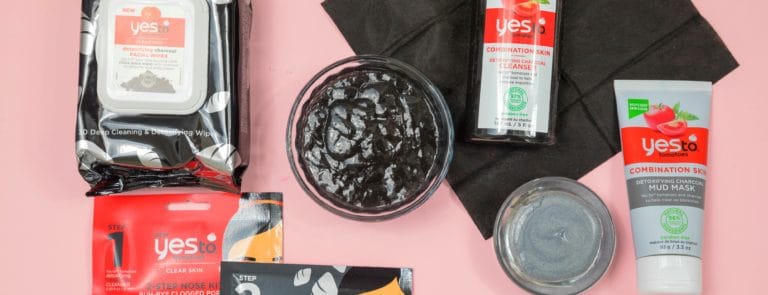20% off €35
Code:EASTER
Why I’m loving… salicylic acid

Struggling with your skin? You’re not alone! One Health Hub reader reveals her salicylic acid success story, while a dermatologist unpacks the science behind this hero
Summary
1What I use
In the mornings I start with a salicylic acid cleanser, followed by a cleansing milk…
2Why I love it
I've noticed my complexion is so much brighter and my skin tone has evened out across my face…
3Why it works
“It’s a highly effective exfoliant,” Dr Ejikeme explains. “As a type of beta hydroxy acid (BHA), it helps target pores…”
When it comes to skincare, it seems that every week there’s a new ‘wonder’ ingredient, super product or high-tech tool we should be adding to our bathroom cabinets. With so many lotions and potions vying for your attention, it’s easy to feel overwhelmed.
Case in point: we’ve noticed salicylic acid doing the rounds as the must-know ingredient that celebrities are reaching for. A-listers like Victoria’s Secret model Kaia Gerber, socialite Poppy Delevingne and even Meghan Markle have raved about the benefits of this exfoliator, said to be particularly effective for blemishes and breakouts.
To understand more about how it could work, we spoke to 28-year-old journalist and Health Hub reader Britt Jones about how it changed her skin. Plus, we consulted leading dermatologist Dr Ifeoma Ejikeme to break down how salicylic acid works and when exactly to add it to your routine.
What I use
I’ve been using a salicylic acid-based cleanser (like this one) for over a year now. I initially stumbled across it when I was first dipping my toes into the world of skincare, as I kept seeing it pop up on every ‘must-have’ beauty list online.

Since then, it’s become a staple in both my AM and PM routines. In the mornings, I start with a cleanser containing the ingredient, followed by a cleansing milk to clear away any overnight dirt. Then, I apply a gentle toner and pat on a hyaluronic acid serum loaded with vitamin C for an extra glow. I’ll finish by layering on a high-factor SPF sunscreen to help keep my skin protected from sun damage.
At night, I stick with the salicylic acid soap, swipe some toner across my oily areas and then alternate between either a collagen cream or a retinoid serum. Right now, I’m also throwing in a few hydrating sheet masks each week to help combat winter dryness. If my undereyes look a little dark, I’ll also dab on a caffeine serum to help brighten things up.
It took a good four weeks before I really started noticing a difference using a salicylic acid-based cleanser as part of my everyday routine. It’s definitely more of a slow-burn product, but when I compare my face now to old photos, the improvement is hard to miss.
Why I love it
Before using salicylic acid, my skin was quite difficult. It’s sensitive and combination-type, so I was constantly dealing with dry, flaky patches or oily areas that would frequently break out - especially in the winter months.
Since I’ve been using it, I've noticed my complexion is so much brighter and my skin tone has evened out across my face. It really feels like it’s working hard to get deep into my pores; clearing them out without leaving my skin feeling stripped or dry.
What I love most about salicylic acid is how easy it is to use. It doesn’t feel like I’m overcomplicating my routine or adding another fussy step, because it’s just part of my everyday cleanser. It’s definitely a go-to product now and a step I can’t imagine skipping.
How else I support my skin
I try to keep my lifestyle in check to give my skin its best chance. Although remembering to drink enough water has always been a struggle for me, I’ve made it one of my New Year’s resolutions to get better.
When it comes to food, I eat a lot less greasy meals now and tend to lean toward fresh produce. I’ve also started focusing more on my internal overall health and wellness too, as I really believe it shows in my face.

Why it works
“The reason why salicylic acid works well with blemish-prone skin is because it’s a highly effective exfoliant,” Dr Ejikeme explains.1 “As a type of beta hydroxy acid (BHA), it helps target pores to dissolve excess oil and break dead skin cells apart, which makes it especially useful for helping reduce blackheads and managing blemishes.2
“As Britt has found, it may also help soothe redness, making it a versatile option for people dealing with blemishes,” she continues.
Is salicylic acid for me?
“It might not be the best choice if you have very dry or sensitive skin, as it can sometimes lead to increased dryness or irritation,” notes Dr Ejikeme. “It’s also important to avoid it if you’re allergic to aspirin, as they share a similar chemical structure."3 Consult your GP if you’re not sure whether you should use salicylic acid, for example if you’re pregnant.
“If your skin is reactive, consider starting with a lower concentration or exploring gentler options like lactic acid for exfoliation, and it’s always a good idea to patch the products on a small area to make sure it’s compatible with your skin.”
If everything checks out, Dr Ejikeme says that salicylic acid can easily become part of your skincare routine via products like cleansers, toners, serums or spot treatments: “If you're new to active ingredients, start by using it two to three times a week and adjust the frequency as your skin builds tolerance,” she advises (use as per product instructions).
“For targeted concerns, like blackheads or blemishes, you can apply it directly to those areas, but just make sure to always follow with a good moisturiser to maintain hydration,” she adds. “Finally, if you’re using active ingredients like acids, it’s always important to wear a protective sunscreen daily.”
Follow the directions on the package label carefully, and ask your pharmacist to explain any part you do not understand. Use salicylic acid exactly as directed. Do not use more or less of it or use it more often than directed on the package or prescribed by your doctor. It's important to not apply to broken skin and only use as directed. If you are unsure if it is for you personally, speak to a dermatologist who might be able to guide you.4
The final say
Ultimately, when it’s used safely and correctly, salicylic acid may be a targeted skincare tool for tackling those blemishes that happen at the least ideal times (hello, work presentation).
As our expert dermatologist advises, a little goes a long way, so start by applying it a few times a week and build up from there, and you’ll avoid causing any further irritation to stressed out skin.
This article provides informational advice and is not a substitute for medical care. Curated by experts for accuracy, we take great care to ensure the information is up-to-date and relevant. However, you should always consult your GP or healthcare professional before using supplements or alternative products, particularly if you have medical conditions or are under supervision.
If you have sensitive skin, eczema, psoriasis, acne or rosacea, consult a dermatologist before trying any treatments.
1. Arif T. Salicylic acid as a peeling agent: a comprehensive review. Clin Cosmet Investig Dermatol [Internet]. 2015 Aug 26 [cited 2025 Feb 10]; 8: 455-61. Available from: https://pmc.ncbi.nlm.nih.gov/articles/PMC4554394/
2. Măgeruşan SE, Hancu G, Rusu A. A Comprehensive Bibliographic Review Concerning the Efficacy of Organic Acids for Chemical Peels Treating Acne Vulgaris. Molecules [Internet]. 2023 Oct 22 [cited 2025 Feb 10]; 28(20): 7219. Available from: https://pmc.ncbi.nlm.nih.gov/articles/PMC10608815/
3. Needs CJ, Brooks PM. Clinical pharmacokinetics of the salicylates. Clin Pharmacokinet [Internet]. 1985 Mar-Apr [cited 2025 Feb 10]; 10(2) 164-77. Available from: https://pubmed.ncbi.nlm.nih.gov/3888490/
4. MedlinePlus. Salicylic Acid Topical [Internet]. MedlinePlus [cited 2025 Feb 10]. Available from: https://medlineplus.gov/druginfo/meds/a607072.html




